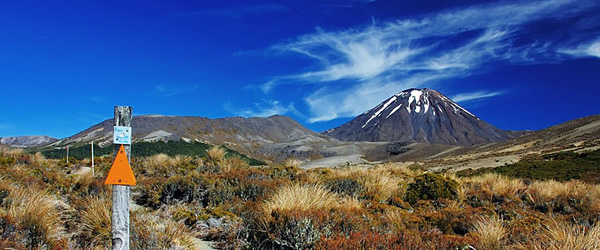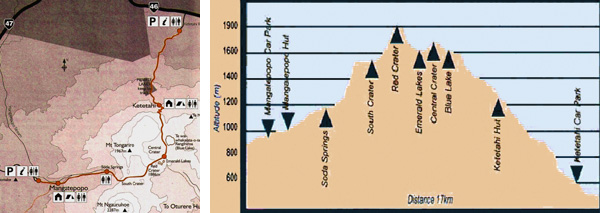|
These Mountains Are Made Of This
GEOLOGY
The Tongariro National Park covers an area of young volcanoes all still active to some degree. Mt Ruapehu to the south, and the tallest of the three mountains, last erupted significantly in 1995 and 1996 including several lahars and the emptying of the crater lake. More recent activity, in 2007 was the generation of a lahar of an estimated 1.4 million cubic metres of mud, rock, and water that thundered down the Whangaehu river after the tephra dam holding back the crater lake burst. Later in 2007, activity also included a hydrothermal eruption where rocks were ejected, one of which crushed the Dome hut.
Ngauruhoe, in the middle, is the youngest of the three volcanoes, having begun formation only 2500 years ago. It presents today as a classic cone volcano, and will be remembered by Lord of the Rings fans as Mt Doom, the part it played in the epic movie trilogy. While most view Ngauruhoe as a separate volcano, it is actually a secondary cone of the Tongariro volcanic complex. Mt Ngauruhoe was most recently active in 1975 and erupted 45 times last century. Until recent times, usually Ngauruhoe could be seen to be producing steam from its crater. Ngauruhoe's eruptions have seldom been more than nine years apart however its steam vents have temporarily cooled, suggesting that the main vent has become blocked and there has been no further activity of any significance since 1975.
Mt Tongariro is the oldest of the three mountains, approximately 10,000 years older than Ruapehu, having first erupted around 260,000 years ago. Consisting of 12 cones, and containing the highest geothermally active system in the country, the most recent significant activity from Tongariro was an eruption of ash from Red Crater, central to the volcanic complex, in 1926. Hot springs and active steam vents can be found in a number of areas on the massif. Tongariro also has a number of explosion craters, some of which have filled with water, forming the spectacular Emerald Lakes, a popular lunch stop along the Tongariro Alpine Crossing track, and the tapu and quite acidic Blue Lake, sacred to the Maori people.
Much of these three volcanoes, particularly Ngauruhoe and Tongariro consist of new, rough volcanic terrain - visible recent lava flows and solidified lava bombs. Much of the upper mountain area is barren, almost entirely lacking vegetation - a combination of altitude and lack of nutrients on the rocky volcanic slopes. The published coordinates for this earthcache will take you to a location part way up the western slopes of Mts Tongariro and Ngauruhoe where some of the formations that make up these mountains can be observed.

|
|
THE TONGARIRO ALPINE CROSSING
To access this earthcache you will need to walk at least part of the 19.4km Tongariro Alpine Crossing track, considered by National Geographic as one of the top ten day walks in the world. The crossing takes approximately 6 to 8 hours to walk comfortably from the usual start at the Mangatepopo Valley carpark to the Ketetahi carpark, perhaps plus some extra time for stops along the way, like searching for caches.
If you plan to walk the whole crossing, you should be aware that you will need to be prepared to spend a number of hours in an alpine area with no shade or vegetation, and no drinking water. A reasonable level of fitness and outdoors confidence is required to undertake the walk and you should go prepared with plenty of water, food and warm waterproof clothing. A map and elevation chart are shown below.

It is a highly recommended walk very popular with overseas tourists, crossing geologically young and active terrain, and affording spectacular views of other mountains and the surrounding central volcanic plateau - just don't hesitate to turn back if the weather turns, and remember the emergency telephone number in New Zealand is 111. More information can be obtained on the official website.
|
|
THIS EARTHCACHE
To claim a find on this earthcache you will need to perform the tasks described below. Failure to provide the required answers via email, or upload the required photo with your online log may result in your log being removed.
1 From the published coordinates, and looking to the east, please describe features that you can see in the rock of the prominent cliffs (eg. formations, layers, etc) and propose your theory on how they formed. The answer to this question must be emailed to the cache owner.
2 From the published coordinates, and looking to the north west, please describe the type and texture of rock on the slopes heading back in the direction of the valley. The answer to this question must be emailed to the cache owner.
3 From the published coordinates, or nearby, please take a photo of the view showing your GPS unit. Be careful not to show the features described in the above questions, and please make sure your GPS unit is visible in the photo. This photo should be uploaded with your online log.
You can log this cache straight away after you have emailed your answers to the cache owner, no need to wait for confirmation. Please include the name of this earthcache in the email - you'd be surprised how many people forget. Also, when contacting us with answers, if you want a reply, please include your email address. Any problems with your answers we'll be in touch.
|